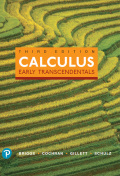
Repeated quadratic factors Refer to the summary box (Partial Fraction Decompositions) and evaluate the following integrals.
83.
Want to see the full answer?
Check out a sample textbook solution
Chapter 8 Solutions
Calculus: Early Transcendentals (3rd Edition)
Additional Math Textbook Solutions
Calculus and Its Applications (11th Edition)
Calculus, Single Variable: Early Transcendentals (3rd Edition)
Thomas' Calculus: Early Transcendentals (14th Edition)
University Calculus: Early Transcendentals (3rd Edition)
- Find the unknown value. 27. y varies jointly with x and the cube root of 2. If when x=2 and z=27,y=12, find y if x=5 and z=8.arrow_forwardplease explain the steps while doing. Thanks. Use the method of partial fractions to evaluate the following integrals.arrow_forwardIntegrate by partial fractions the followingarrow_forward
- 1. Find / 2(3z+ 4)² dz.arrow_forwardStan and Ollie work on the integral J2x(a* + 2) di. Stan lets u = x? + 2 and proceeds to get (x + 2) + C. Ju du + C. + C = 2 Ollie multiplies out the function under the integral and gets |(21 + 4x) dx x* + 2x? + C. 2 How can they both be right?arrow_forwardUse right and left endpoints and the given number of rectangles to find two approximations of the area of the region between the graph of the function and the x-axis over the given interval. f(x) = 2x + 2, [0, 2], 4 rectangles Step 1 To find two approximations of the area of the region between the graph of the function f(x) = 2x + 2 and the x-axis over the interval [0, 2] using 4 rectangles, first partition the interval [0, 2 ] into n = Then the width of each rectangle is given by using the following formula. b - a Step 3 Ax = Step 2 Therefore, the width of each rectangle is b - a n Ax = n -0.5 4 Consider the right endpoints approximation of the area of the region. Then substitute Ax = 2 Observe the region between the graph of the function f(x) = 2x + 2 and the x-axis over the interval [0, 2] with four circumscribed rectangles, which is shown below. Submit - 0 6 5 3 0.5 1.0 The right endpoints of the n intervals are Ax(i) where i = 1 to 4 1.5 Thus, the right end points of four…arrow_forward
- Algebra & Trigonometry with Analytic GeometryAlgebraISBN:9781133382119Author:SwokowskiPublisher:Cengage
 Algebra: Structure And Method, Book 1AlgebraISBN:9780395977224Author:Richard G. Brown, Mary P. Dolciani, Robert H. Sorgenfrey, William L. ColePublisher:McDougal Littell
Algebra: Structure And Method, Book 1AlgebraISBN:9780395977224Author:Richard G. Brown, Mary P. Dolciani, Robert H. Sorgenfrey, William L. ColePublisher:McDougal Littell


